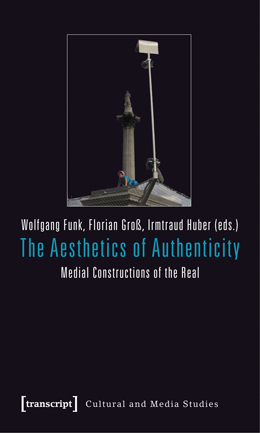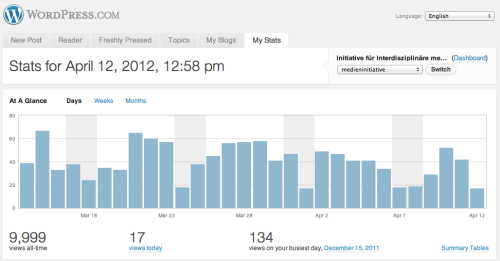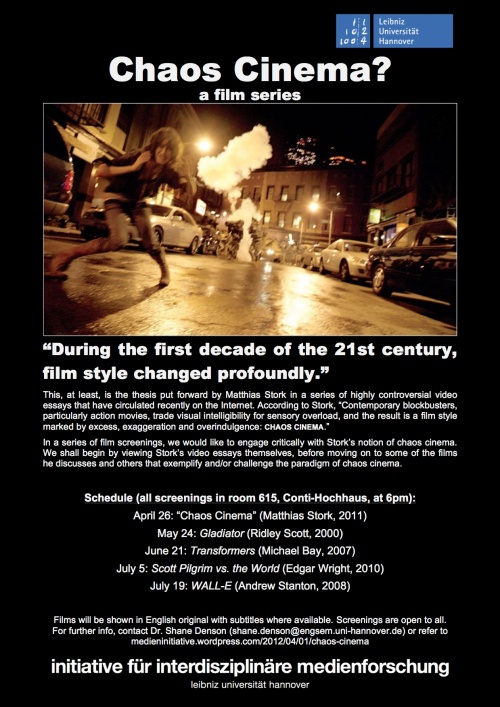[scribd id=91800427 key=key-1sffli6pmlw9jbtn68xd mode=list]
Month: April 2012
Speculation
[vimeo 39947942 w=500 h=281]
Patrick Jagoda, assistant professor in the English Department at the University of Chicago and co-editor of Critical Inquiry, recently informed me of a project he’s been working on and asked me to spread the word, which I gladly do:
As Patrick puts it, it’s “a transmedia game (or ‘alternate reality game’)” that he’s “co-directing with Katherine Hayles (Duke) and Patrick LeMieux (Duke), and designing with several people at the University of Chicago, Duke, and the University of Waterloo. The game, called Speculation, launched just a few days ago and will continue for several weeks. It has a science fiction narrative and confronts finance culture and the recent economic crisis. The latest trailer is here: vimeo.com/39947942. It leads to the main game site at: http://speculat1on.net/ (complete with a discussion forum, cryptographic puzzles, games of various genres, narrative pieces, audio, and much more). There’s also a related Facebook page that belongs to Nex Noitaluceps.”
I’ve poked around the site a bit, and it’s really quite intriguing, so do check it out!
Mark B.N. Hansen on Media as Environment (for Life)
On Wednesday, April 25, 2012, the Film & TV Reading Group will meet at 6:00 pm in room 615 (Conti-Hochhaus) to discuss Mark Hansen’s article “Media Theory,” (from Theory, Culture & Society 23.2-3 (2006): 297-306). In this piece, Hansen importantly rethinks media beyond their apparatic, empirical determinations (devices, machines, storage media, etc.), instead conceiving media as “the environment for life.” The argument behind this approach is outlined in the paper’s abstract:
Poised on the cusp between phenomenology and materiality, media institute a theoretical oscillation that promises to displace the empirical-transcendental divide that has structured western meditation on thinking, including the thinking of technics. Because media give the infrastructure conditioning thought without ceasing to be empirical (i.e. without functioning as a transcendental condition), they form the basis for a complex hermeneutics that cannot avoid the task of accounting for its unthematizable infrastructural condition. Tracing the oscillation constitutive of such a hermeneutics as it serves variously to constitute media theory in the work of critics from McLuhan to Kittler, from Leroi-Gourhan to Stiegler, my interrogation ultimately conceptualizes the medium as an environment for life: by giving concrete form to ‘epiphylogenesis’ (the exteriorization of human evolution), concrete media find their most ‘originary’ function not as artifacts but via their participation in human technogenesis (our co-evolution with technics).
Hansen’s reconceptualization of media has been a key point of reference in my own attempts to theorize the ecology of “postnaturalism,” which turns on the notion of a constantly evolving “anthropotechnical interface.” One of the things that I tried to do in my engagement with Hansen’s thought was to expand it and to push the notion of media as environment beyond the qualification “for life,” arguing that media constitute the environment for agency in a broader sense, both living and non-living. One could say, in fact, that this is equivalent to saying that media constitute the environment period. And, interestingly, in the video above (from the transmediale 2011), we find Hansen working towards precisely this type of expanded approach: a non-anthropocentric, non-biocentric, positively cosmological notion of media.
The Aesthetics of Authenticity
I am pleased to announce The Aesthetics of Authenticity: Medial Constructions of the Real, an essay collection co-edited by two of my colleagues, Wolfgang Funk and Florian Groß, along with Irmtraud Huber from the University of Berne. The book will appear in early May with German publisher Transcript. Here is a short abstract for the collection:
“As a concept that increasingly gains importance in contemporary cultural discourse, authenticity emerges as a site of tearing tensions between the fictional and the real, original and fake, margin and centre, the same and the other.
The essays collected in this volume explore this paradoxical nature of authenticity in the context of various media. They give ample proof of the fact that authenticity, which depends on giving the impression of being inherent or natural, found not created, frequently turns out to be the result of a careful aesthetic construction that depends on the use of identifiable techniques with the aim of achieving certain effects for certain reasons.”
And here is the Table of Contents:
“Exploring the Empty Plinth. The Aesthetics of Authenticity” (Wolfgang Funk, Florian Groß, and Irmtraud Huber)
FRAGMENTATIONS
“Authenticity as an Aesthetic Notion. Normative and Non-Normative Concepts in Modern and Contemporary Poetics” (Susanne Knaller)
“Found Objects. Narrative (as) Reconstruction in Jennifer Egan’s A Visit from the Goon Squad” (Wolfgang Funk)
“Monolithic Authenticity and Fake News. Stephen Colbert’s Megalomania” (Seth Hulse)
“Authentic Bodies. Genome(s) vs. Gender Norms in Oryx and Crake, The Year of the Flood, and BioShock” (Sven Schmalfuß)
CONTESTATIONS
“‘The Real Thing.’ Authenticating Strategies in Hemingway’s Fiction” (Melanie Eis)
“Real Lives – Living Wild. Authenticity, Wilderness, and the Postmodern Robinsonade in James Hawes’s Speak for England and Jeanette Winterson’s The Stone Gods (Francesca Nadja Palitzsch)
“Monica Ali and the Suspension of Disbelief” (Melanie Mettler)
PERFORMANCES
“Poet and the Roots. Authenticity in the Works of Linton Kwesi Johnson and Benjamin Zephaniah” (David Bousquet)
“The Dilettantish Construction of the Extraordinary and the Authenticity of the Artificial. Tracing Strategies for Success in German Popular Entertainment Shows” (Antonius Weixler)
“‘Brooklyn Zack is Real’: Irony and Sincere Authenticity in 30 Rock” (Florian Groß)
“Authentic Simulacra or the Aura of Repetition. Experiencing Authenticity in Tom McCarthy’s Remainder” (Irmtraud Huber and Sophie Seita)
Of Baboons, Touchscreens, and 4-Letter Words: Or, Nonhuman Agency and an Object-Oriented Perspective on the Pre-Discursive Origins of Language
[youtube http://www.youtube.com/watch?v=3dhUPpBOXr8]
As Sharon Begley puts it in her article for Reuters (“This is Dan. Dan is a Baboon. Read, Dan, Read”): “No one is exactly using the words ‘reading’ and ‘baboons’ in the same sentence, but a study published Thursday comes close.”
In a sense, though, the temptation to describe the implications of that study (summarized in the video above) as a demonstration that “baboons can read” is just another iteration of a familiar tendency to anthropomorphize nonhuman primates rather than to draw the converse and much more interesting sorts of conclusions suggested by observing these animals’ behavior: Rather than humanizing apes, I suggest, we should be led by studies like this one to relax our anthropocentric perspectives and to appreciate the nonhuman aspects of those activities and skills, such as language-use, that are typically seen to distinguish us most centrally as human.
While the implications of the experiment shown here are interesting from a wide variety of scientific and philosophical perspectives, they are of especial interest from a media-theoretical perspective, especially one (like mine) that’s interested in pre-, sub-, or non-discursive interactions between bodies and things.
To quote again from Begley’s article:
The study was intended less to probe animal intelligence than to explore how a brain might learn to read. It suggests that, contrary to prevailing theory, a brain can take the first steps toward reading without having language, since baboons don’t.
“Their results suggest that the basic biological mechanisms required for reading have deeper evolutionary roots than anyone thought,” said neuroscientist Michael Platt of Duke University, who co-authored an analysis of the study. “That suggests that reading draws on much older neurological mechanisms” and that apes or monkeys are the place to look for them.
Reading has long puzzled neuroscientists. Once some humans started doing it (about 5,000 years ago in the Middle East), reading spread across the ancient world so quickly that it cannot have required genetic changes and entirely new brain circuitry. Those don’t evolve quickly enough. Instead, its rapid spread suggests that reading co-opted existing neural structures.
Furthermore, as this article at BBC Nature succinctly puts it: “The results suggest the ability to recognise words could more closely relate to object identification than linguistic skill.”
Dr Grainger [one of the scientists responsible for the study] told BBC Nature that recognising letter sequences – previously considered a fundamental “building block” of language – could be related to a more simple skill.
“The baboons use information about letters and the relations between letters in order to perform our task… This is based on a very basic ability to identify everyday objects in the environment,” he said.
Of course, it’s not like this settles things, but it does suggest some interesting correlations between eyes, hands, and objects — embodied, techno-material correlations of a straightforwardly nonhuman sort — that would seem to be basic to the constitution of discursive (human) subjectivities, and not vice versa. Thus, rather than bringing the apes into the citadel of humanity, perhaps we should let them lead us out of the prison-house of language!
Number of the Day: 10,000
10,000: As of today, the number of page views on this blog since its inception in May 2011.
Today, sometime between 1:00 and 3:30 p.m., this blog had its 10,000th page view, when a visitor from either Spain, Canada, or Germany (in which case it was very possibly my wife) clicked on this site, either deliberately or (as I’m told happens occasionally on the interwebs) by chance.
Admittedly, 10,000 hits over the course of 11 months is not a whole lot in comparison with the kind of traffic that corporate sites, media outlets, universities, or even some of the more popular academic bloggers get, but it’s nevertheless not an altogether insignificant milestone for a fledgling media initiative at a German university posting largely on local events, niche-interest topics like seriality or posthumanism, or whatever happens to interest me at the time.
I thought I’d take the opportunity, therefore, to review and take stock of things. Luckily, WordPress provides a range of interesting statistics that are perfect for this kind of occasion.
To start with, 122 posts (this one included) have been made since I set up the blog on May 5, 2011. There were only 2 visitors to the blog that May (I didn’t go public with the blog until June, so who knows what led those two poor souls here then), roughly 200 hits in June, and since November 2011 the blog’s been averaging about 1500 monthly page views.
The five most popular pages have been: 1. the main landing page (4,668 hits), 2. Conference Program: “Cultural Distinctions Remediated” (detailing the conference we held here in December 2011; 366 hits), 3. the About page (235 hits), 4. Bollywood Nation (our film series in the winter semester 2011/2012; 188 hits), and 5. Bollywood Nation: Background / Context (likewise 188 hits).
Most people arrive here by way of a search engine (4,260 referrals total, including 3,329 from Google Image Search, 838 from “normal” Google searches, 28 from Bing, and a handful of others). There have also been 485 referrals from Facebook, 279 from Twitter, 259 from the English department at the Leibniz Universität Hannover, 93 from Jason Mittell’s blog Just TV, 93 from the homepage of the Popular Seriality research group, and lately an increasing number of referrals from Jussi Parikka’s Machinology blog, Steven Shaviro’s The Pinocchio Theory, Dylan Trigg’s Side Effects, and Bernard Dionysus Geogehan’s homepage.
Lately we’ve seen more and more people landing here deliberately (as evidenced by these referrals and the increasing number of people searching for terms like “medieninitiative hannover” or “denson postnaturalism”), but the list of top search terms evidences a mixed audience of intentional and accidental readers. The all-time top five search terms are: 1. television, 2. cheezburger 
And finally, WordPress has recently started providing statistics on the countries where the blog’s visitors (or at least their IP addresses) are located. Statistics are only available since February 25, but since then the top five countries have been: 1. United States (454 hits), 2. Germany (437), 3. United Kingdom and Canada (tied at 177 each), 4. India (103), and 5. Australia (69).
So that’s where we’ve been, but where is the blog heading? What does the future hold? To be sure, only time will tell, but a number of things are in the works right now: the Media Initiative continues to develop, and a number of media-related events are being planned in Hannover (and elsewhere), so be on the lookout, and consider subscribing to the blog via e-mail (you can sign up on the right), an RSS reader of your choice, or your WordPress account, for example. Additionally, spread the word via your favorite social network, blog, or other modern mode of communicative being. And if that’s not enough, don’t forget: we’ve got plenty of cheezburgers, traffic, and metabolism for all your spambots!
Chaos Cinema? A Film Series
(click on image for larger view)
“During the first decade of the 21st century, film style changed profoundly.”
This, at least, is the thesis put forward by Matthias Stork in a series of highly controversial video essays that have circulated recently on the Internet. According to Stork, “Contemporary blockbusters, particularly action movies, trade visual intelligibility for sensory overload, and the result is a film style marked by excess, exaggeration and overindulgence: chaos cinema.”
In a series of film screenings, we would like to engage critically with Stork’s notion of chaos cinema. We shall begin by viewing Stork’s video essays themselves, before moving on to some of the films he discusses and others that exemplify and/or challenge the paradigm of chaos cinema.
For those interested, here are some links to useful background and discussion:
First, Stork’s thesis must be seen against the background of David Bordwell’s notion of “intensified continuity,” which is seen to mark a change from the classical Hollywood style that dominated American cinema from around 1920 until (at least) the 1960s. Chaos cinema, according to Stork, goes further in effecting a radical break with continuity principles, whether classical or intensified.
Another important context is Steven Shaviro’s book Post-Cinematic Affect, which introduced the term “post-continuity.” (A Google Books preview can be found here, but note that approximately two-thirds of the book appeared in the open access journal Film-Philosophy under the title “Post-Cinematic Affect: On Grace Jones, Boarding Gate and Southland Tales“.) More recently, Shaviro has returned to the topic and reflected explicitly on Stork’s notion of chaos cinema in a talk given at the 2012 annual conference of the Society for Cinema and Media Studies, reprinted in full on his blog The Pinocchio Theory.
And here, finally, is the schedule of screenings (note that all screenings will be held in room 615 of the Conti-Hochhaus, at 6:00 pm):
April 26, 2012: “Chaos Cinema” (Matthias Stork, 2011)
May 24, 2012: Gladiator (Ridley Scott, 2000)
June 21, 2012: Transformers (Michael Bay, 2007)
July 5, 2012: Scott Pilgrim vs. the World (Edgar Wright, 2010)
July 19, 2012: WALL-E (Andrew Stanton, 2008)
Films will be shown in English original with subtitles where available. Screenings are open to all, so feel free to spread the word!


